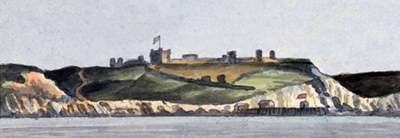
Moats Bulwark was a fort constructed by Henry VIII in 1539 to protect the port of Dover from French or Spanish attack. It was a small, earthwork and timber gun platform, designed to hold perhaps up to six heavy naval guns. It was reconstructed in stone around 1750, and only fragments survive today.
History

During the medieval period the port of Dover was protected by a castle and a sequence of walls, but by the start of the 16th century these were outdated. The town walls had fallen into decline, and Dover Castle’s defences were outdated, and vulnerable to gunpowder weapons. When international tensions with France and Spain increased in the 1530s, King Henry VIII decided to strengthen the defences with new bulwarks at Moats Bulwark and Archcliffe Fort, equipped with anti-naval artillery guns.
Moats Bulwark was constructed at the bottom of the cliffs under the castle walls. It probably took the form of a earthwork gun platform, revetted in timber, designed to hold around six heavy weapons, and linked to the main defences by tunnels in the cliff. It would not have been a powerful fortification, and the historian Jonathan Coad describes its construction as a largely token gesture.
Around 1750, the bulwark was entirely redesigned in stone as a large, semi-circular gun battery. A spiral stairway was constructed within the cliffs in 1856 to link it to the castle above. In the 21st century, only fragments of the bulwark remain, which are protected under UK law as a Scheduled Monument.
Bibliography
- Coad, Jonathan. (2007) Dover Castle. English Heritage: London, UK.
- Coad, Jonathan. (2011) Dover Castle: A Frontline Fortress and its Wartime Tunnels. English Heritage: London, UK.
Attribution
The text of this page is licensed under under CC BY-NC 2.0. Images on this page include those from the Yale Centre for British Art, licensed as follows: Moats Bulwark, late-18th century (Public Domain).
